#Larry Roquemore
Explore tagged Tumblr posts
Text
Larry and the Blue Notes-"Night of the Sadist".
youtube
[Larry]Roquemore (sax & vocals) explains that several urban legends inspired the tune, including "the escaped mental patient with a hook on his right hand who used to terrorize parkers in Lover's Lane; a guy dressed in a gorilla suit who used to tap on car windows of couples parking late at night at my old school, Northside High; and tales of a Goat Man who was scaring the crap out of parkers at Lake Worth".
#larry and the blue notes#night of the sadist#night of the phantom#larry roquemore#larry slater#jack hammonds#buddy bates#randy cates#garage rock#proto punk#7'' single#1965#Youtube
5 notes
·
View notes
Text
Kirstie (2013-14)
In today's review, I find out that long lost relative might be the ticket to the stars... or at least a Tony Award. as I attempt a #positive review of the short-lived sitcom, Kirstie. #KirstieAlley #EricPetersen #RheaPerlman #MichaelRichards
It is daunting to think about the road not travelled; what if I picked that class, over the other one, or stayed where we were instead of upping roots to greener pastures? How would your life be different then? Would it be better or worse? And if better, how would we make up for it? Would it be worth it? In 2013, a Broadway star and the plight of an adoptee child might be enough to make some…

View On WordPress
#2013#2014#Bryan Callen#Christopher McDonald#Cloris Leachman#comedy#Eric Petersen#Geoff Pierson#George Wendt#Gilles Marini#Jason Alexander#John Travolta#Kathy Griffin#Kirstie Alley#Kristen Johnston#Kristin Chenoweth#Larry Joe Campbell#Lindsey Kraft#Lucila Sola#Michael Dunn#Michael Richards#positive#review#Rhea Perlman#Richard Burgi#Tim Bagley#TV Series#TV Show#Valerie Mahaffey#Xosha Roquemore
0 notes
Video
youtube
Performed by: George Chakiris, Carole D’Andrea, Rudy Del Campo, Jose De Vega, Suzie Kaye, Nobuko Miyamoto, Rita Moreno, Nick Navarro, Jay Norman, Jaime Rogers, Larry Roquemore, Andre Tayir, Robert E. Thompson, Gina Trikonis, Gus Trikonis, Eddie Verso, and Yvonne Wilder
Number: “America”
Choreographer: Jerome Robbins
Style: Broadway
From: West Side Story (1961)
#dance#west side story#broadway#george chakiris#rita moreno#carole d'andrea#rudy del campo#jose de vega#nobuko miyamoto#suzie kaye#nick navarro#jay norman#jaime rogers#larry roquemore#andre tayir#robert e. thompson#gina trikonis#gus trikonis#eddie verso#yvonne wilder#choreography#jerome robbins#musicals#1960s#1961#vintage ads#retro#old hollywood#dancers#dancing
12 notes
·
View notes
Audio
The Midways - Night of the Sadist (2003) Larry Roquemore / Larry Slater Larry and The Blue Notes Cover from: "Pay More and Get a Good Seat" LP
Personnel: Dave Pauwels: Vocals / Bass Johnny Martin: Guitar Peter Chapman: Keyboards Christopher Dignan: Drums
*** ***

Larry and The Blue Notes - Night of the Sadist (1965) https://tmblr.co/ZoHQpk2RV-Edg
(AKA “Night of the Phantom”)
#Night of the Sadist#The Midways#Larry and The Blue Notes#Garage Revival#Garage#Toronto#Canadian#2000's#Larry Slater#Larry Roquemore#Pay More and Get a Good Seat#Replacing Dead Links#Kiwi6
18 notes
·
View notes
Photo





Kirstie - TV Land - December 4, 2013 - February 26, 2014
Sitcom (12 episodes)
Running Time: 30 minutes
Stars:
Kirstie Alley as Madison "Maddie" Banks (born Brenda Kluszewski)
Eric Petersen as Arlo Barth
Rhea Perlman as Thelma Katz
Michael Richards as Frank Baxter
Guest cast
Gilles Marini as Michel
Xosha Roquemore as Tanya
Richard Burgi as Tony Cameron
Bryan Callen as Lucas Kogen
Larry Joe Campbell as Clown
Lucila Sola as Lucila
Tim Bagley as Robber
Michael Dunn as Kevin
Geoff Pierson as Hugh Winters
Valerie Mahaffey as Victoria Winters
Lindsey Kraft as Melissa Winters
3 notes
·
View notes
Text
BOTTOMS UP
April 13, 1934
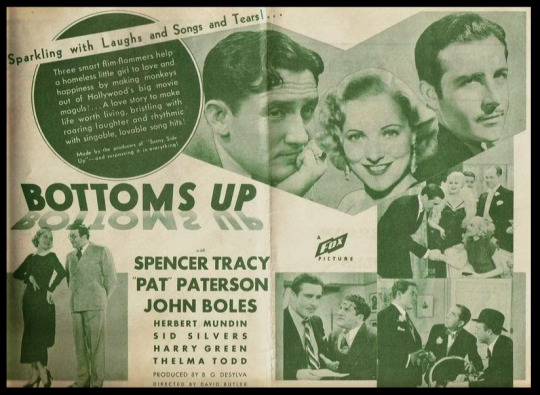
Directed by David Butler
Produced by Buddy G. DeSylva for 20th Century-Fox
Written by David Butler, Buddy G. DeSylva, and Sid Silvers
Choreography by Harold Hecht
Synopsis ~ Spencer Tracy stars as fast-buck promoter Smoothie King. Our hero's latest scam is to pass off Hollywood extra Wanda Gale (Pat Patterson) and forger Limey Brook (Herbert Mundin) as British nobility, getting both of them prestigious jobs at a movie studio. Eventually Wanda becomes a big star, falling out of love with Smoothie along the way in favor of her leading man Hal Reed (John Boles). But Smoothie takes it all in stride; after all, there's still a world full of chumps and suckers, ripe for fleecing.
CAST
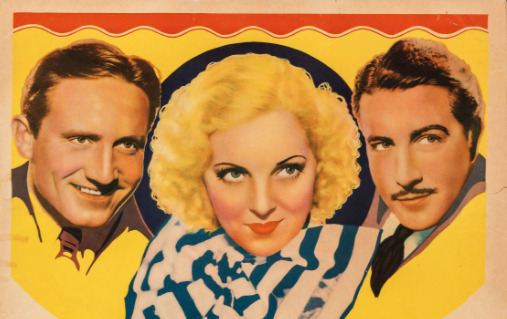
Spencer Tracy (’Smoothie’ King) won two Oscars and was nominated seven other times in his long career. This is his only musical. He also appeared with Lucille Ball in Without Love (1945).
John Boles (Hal Reed) also did Thousands Cheer (1943) with Lucille Ball).
Pat Paterson (Wanda Gale) was married to Charles Boyer. This is her only film with Lucille Ball.
Herbert Mundin (Limey Brook) was an English-born actor making his only film with Lucille Ball.
Sid Silvers (Spud Mosco) was also the co-writer of this film. This is his only movie with Lucille Ball.
Harry Green (Louis Baer) makes his only film with Lucille Ball.
Thelma Todd (Judith Marlowe) was known as ‘The Ice Cream Blonde' and ‘Hot Toddy'. This is her only film with Lucille Ball.
Robert E. O'Connor (Detective Rooney) went on to do five more films with Lucille Ball.
Dell Henderson (Lane Worthing) went on to do five more films with Lucille Ball.
Suzanne Kaaren (Secretary) makes her only screen appearance with Lucy.
Douglas Wood (Baldwin) also appeared with Lucille Ball in Her Husband’s Affairs (1947).
UNCREDITED CAST
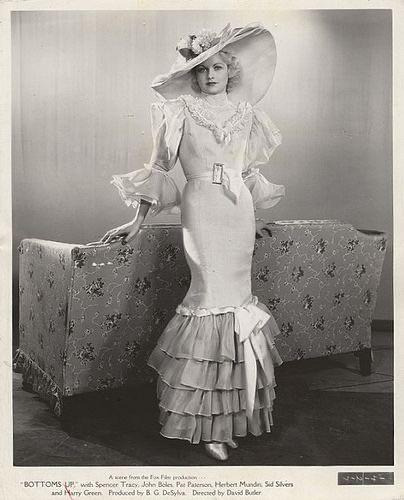
Lucille Ball* (Chorine) makes her eighth film since coming to Hollywood in 1933.
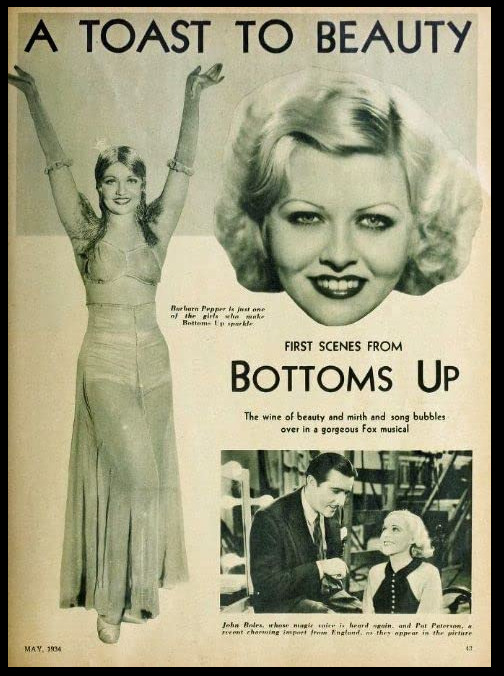
Barbara Pepper* (Chorine) made six films with Lucille Ball, including her Lucy’s first, Roman Scandals (1933). The two became friends, and she was one of the first people Lucille Ball wanted for the role of Ethel Mertz after Bea Benadaret passed. Pepper’s drinking made her a risk for the network and sponsor, but she went on to make ten appearances on “I Love Lucy”.
Chorines: Lee Auburn, Bonnie Bannon*, Lynn Bari, Dolores Casey*, Irene Coleman, Ann Darcy, Jean Gale*, June Gale, Sugar Geise, Betty Gordon, Jane Hamilton, Vivian Keefer*, Laura La Marr, Mary Lange*, Shirley Lloyd, Dona Massin, Ruth Moody, Vera Payton, Virginia Ray, Beverly Royde, Katharine Snell, Alice Stombs, Valerie Traxler
Party Guests: Richard Carle, Cecil Cunningham, Opal Ernie, Paul McVey, Ronald R. Rondell, Henry Roquemore, Loretta Rush, Larry Steers, Ferdinand Munier
Minor Roles: Peggy Beck, Georgia Clarke, Elizabeth Cooke, Patricia Dobbs, Dee Dowell, Jean Fursa, Kathryn Hankin, Betty Neitman, Ellen Thomas, Mildred Unger
* Goldwyn Girls on loan to Fox. As they are not in a Sam Goldwyn picture, they are not credited as Goldwyn Girls.
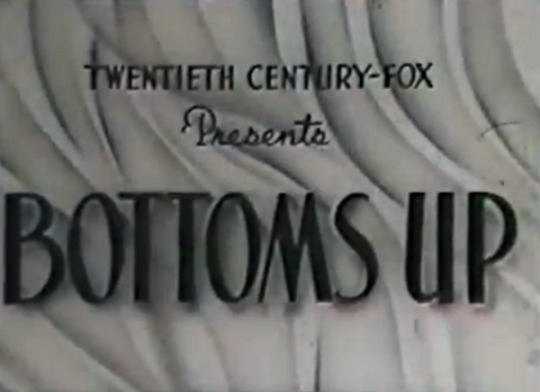
OTHERS
David Field (Reporter)
Allen Connor (Ticket Taker)
Walter Hardwick (Waiter)
Teddy Hart (Chorus Boy)
Samuel E. Hines (Bellboy)
Arthur Loft (Yes Man)
John T. Murray (Radio Announcer)
Ned Norton (Yes Man)
Frank O'Connor (Jack, Director)
Virginia Pine (Showgirl)
Sam Wolfe (Harmonica Player)
Ernest Wood (Hotel Clerk)
Johnny Boyle (Dance Specialty)
SOUNDTRACK
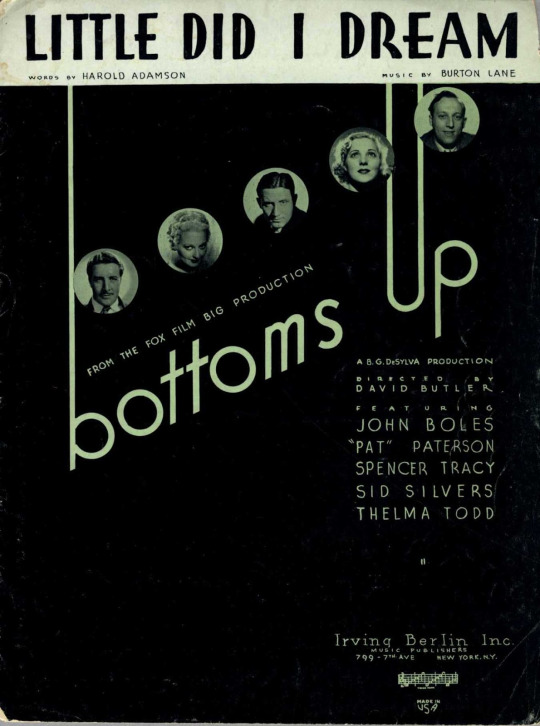
“Little Did I Dream” by Harold Adamson and Burton Lane
“Turn on the Moon” by Harold Adamson and Burton Lane
“I'm Throwing My Love Away” by Harold Adamson and Burton Lane
“Waitin' at the Gate for Katy” by Richard A. Whiting and Gus Kahn
“Is I in Love? I Is” J. Russel Robinson
Opera Singer: I've always considered myself a virtuoso. 'Smoothie' King: I didn't ask about your morals.
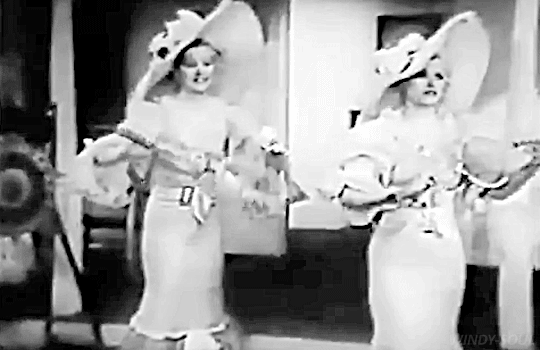
Lucille Ball was paid $75 dollars a week when she was loaned out to Fox by RKO to make this film. She appears in the song “Waitin’ at the Gate for Katy.”

The film received a favorable review from The New York Times critic Mordaunt Hall, who called it "a neat, carefree piece of work, which is helped greatly by Spencer Tracy, Pat Paterson, an English actress who here makes her American picture bow; Herbert Mundin, Harry Green, and, to a lesser extent, by John Boles" and noted that it "has its full share of honest humor and also several tuneful songs." Nonetheless, it was a box office disappointment for Fox.
5 notes
·
View notes
Link
Rudy Ray Moore, the self-proclaimed “ghetto expressionist” behind two of the wildest 1970s cult films is receiving newfound attention thanks to the Netflix biopic Dolemite Is My Name. Moore’s first two films, Dolemite (1975) and The Human Tornado (1976), were so popular that we easily forget he was more than just his dadbod kung fu character. While staying true to his raunchy comedy self, Moore’s subsequent two films, Petey Wheatstraw (1977) and Disco Godfather (1979), pushed his style to surprisingly macabre places, creating films that should be remembered as examples of the horror-noire genre.
Written and directed by frequent Moore collaborator Cliff Roquemore, Petey Wheatstraw follows the title character (Moore), nightclub comedian and kung-fu master who, after being gunned down at a funeral by some underworld thugs, strikes a deal with the Devil. He will get his life back, but only if he marries the Devil’s famously ugly daughter. He agrees and imbued with the supernatural powers of Satan’s mighty cane, Petey wages war on the nightclub owners who put the hit out on him, all while scheming a way out of getting hitched in Hell.
Petey Wheatstraw is a raunchy horror-comedy influenced by the pop-horror of the mid-’70s while still leaning into Moore’s hilarious low-budget aesthetic. A scene in which Petey wreaks psychic havoc is an obvious riff on the previous year’s release Carrie. While it doesn’t look nearly as good as Brian De Palma’s famous prom scene, the wholehearted attempt is as endearing as the costumes the film’s demons wear, which are reminiscent of children’s theatre.
Moore’s character in Petey Wheatstraw also evokes the sensibilities of a late-night horror host, complete with spooky rhythm, raunchy double entendres, and a fourth wall made to be broken. You can imagine Petey rubbing shoulders with everyone from Elvira and Svengoolie to even Coffin Joe, the Brazilian film icon and horror host created and performed by Jose Mojica Marins.
Coffin Joe features in a series of films that Moore’s later works have been compared to. Like Petey Wheatstraw, he is an emblematic character played by an unmatchable showman, despite Marins’ films being much darker than Moore’s. But the comparisons to Moore is really less in who the character is and more in the style and visual language of Marins’ films. Beginning with At Midnight I’ll Take Your Soul (1964), the Coffin Joe series is filled with Halloween motifs and swirling dark imagery for its ghouls to maniacally emerge from, rushing at the screen in a hallucinatory haze.
The influence of Marins’ dreamy style is perhaps most evident in Moore’s final film of the 1970s, Disco Godfather. Equal parts disco odyssey, kung-fu comedy, and horror film, it’s Moore at his most magnetic and boisterous. Written and directed by J. Robert Wagoner, the film follows Moore as Tucker, an ex-cop turned club owner who starts a crusade against the new street drug Angel Dust after his nephew is pushed into a bad trip. Like Petey Wheatstraw, this isn’t conventional horror, but it is filled with drugged-out visions of Hell that look to not only be inspired by the spookiness of Coffin Joe but also the expressionism of Mario Bava and the white-faced demons of ’60s Japanese horror films.
The wack-fueled hallucinations – demonic basketball players, EC Comics skeletons, ghoulish Sergio Stivaletti-style Angels of Death – were in part brought to life by Disco Godfather’s art director, Robert A. Burns. And, if you look at his resume, you can see why they are so damn good. This is a man who was just coming off of both Tobe Hooper’s The Texas Chain Saw Massacre and Wes Craven’s The Hills Have Eyes before going on to work with some of the biggest names in the genre, like Joe Dante, Stuart Gordon, and Larry Cohen. Hell, he even worked on Microwave Massacre, a tasteless horror-comedy classic that would have been right up Moore’s raunchy alley. Burns knew his horror, and that knowledge helps make Disco Godfather’s spooky beats pop over 40 years later.
But Disco Godfather was rated PG, which many felt castrated Moore’s trademark dirty humor, especially with the film’s gonzo anti-drug PSA tone. In spite of this rating, the filmmakers resisted cringeworthy afterschool-special tropes by really emphasizing the story’s horror beats with an undercurrent of disquiet and malaise in its addiction urban legends. These real-life horrors, along with healthy doses of spooky viscera, are what earn Disco Godfather its horror-noire stripes.
The film’s nightmare energy crescendos in the finale as Tucker is force-fed Angel Dust through a gas mask, turning a drug den into a house of horrors. And while you can poke fun at the over-the-top zeal of Moore in this moment, the last shot is a jarring, brain boiling cap on an ending that must be seen to be believed. Which is a perfect summation of Rudy Ray Moore’s four-film run in the ’70s. He’s a filmmaker that wanted to shock you, push you off balance, leave you feeling something. Typically it was with his balls-to-the-wall humor, but especially with Disco Godfather, he had more macabre tricks up his sleeve than we’ve given him credit for.
I’m not saying that Rudy Ray Moore was a master of horror. But the fact remains that of the four films he put out in the ’70s, half of them are quasi-horror, which means he deserves to be remembered for his contributions to the genre. He helped create some of the most unique, bizarre horror moments of the decade. These films aren’t horror-noire classics like Abby or Blackenstein: they are something else entirely. Something else that, again, you’ve just got to see to believe.
#rudy ray moore#rip#horror-noire#horror noire#black horror#black cinema#black film#black films#1975#1976#1977#1979#dolemite#dolemite is my name#the human tornado#petey wheatstraw#disco godfather#coffin joe#cliff roquemore#mario bava#j. robert wagoner#angel dust#robert a. burns#abby#blackenstein#film#films#blaxploitation#film school rejects
5 notes
·
View notes
Audio
Larry and The Blue Notes - Night of the Sadist (1965) Larry Roquemore / Larry Slater from: "Night of the Sadist" / "All My Own"
(AKA "Night of the Phantom")

Larry and The Blue Notes
#Night of the Sadist#Larry and The Blue Notes#60's#Garage#Texas#Fort Worth#Fort Worth Texas#Larry Slater#Larry Roquemore#Night of the Phantom#Replacing Dead Links#audio-tut.ru#Tiris Records
30 notes
·
View notes